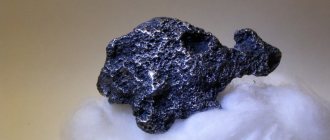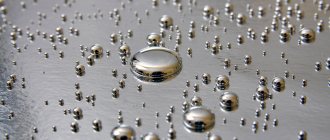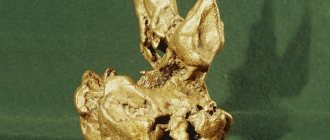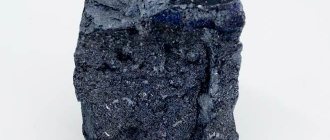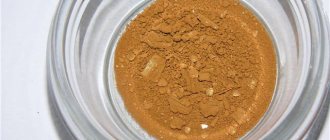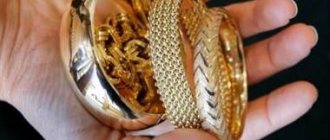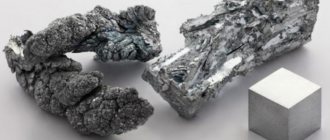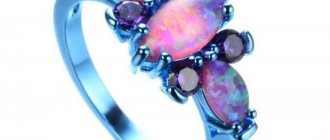Chemical composition
Chemically pure gold is almost never found in nature. Usually contains impurities of silver (Ag), copper (Cu), and less often other metals, with which it forms solid solutions.
The most common impurities are Ag, Cu, Fe, Te, Se, less often Bi, Pt, Ir, Rd (with a significant content of impurities, varieties of gold are distinguished). Mg, As, Mn, Ni are determined spectroscopically. Primary gold from low-temperature deposits is generally richer in silver than gold from high-temperature deposits; Secondary gold (redeposited) is poor in silver.
Varieties of gold
Electrum - electrum - (Au, Ag). Contains up to 10-15% Ag. Named from the Greek - amber - due to the similarity of color (Pliny). Synonym for silver gold. It is observed in the form of grains, plates, lumps, dendrites, and sometimes crystals. Predominant forms: (111), (100). Doubles by (111). There is no cleavage. The fracture is hooked. Very malleable and viscous. Hardness 2-3. Density 12.5—15.6. The color is light yellow to silver-white and greenish ("green" gold from Baley). The streak is metallic and shiny. Opaque. Good conductor of electricity. The reflectivity is very high, but lower than that of gold and silver. Isotropic. HNO3 is poisoned (it dims slightly from the vapors, sometimes boils slightly); from KCN it darkens with the formation of a rough surface; from FeCl3 it sometimes turns slightly brown and iridescent, from HgCl2 it becomes brown to black and iridescent. The Ag content in electrum is above 25%, usually 30-45%. Melting point is 1061° with an Ag content of 35.4% and 1046° with an Ag content of 39.9%. More rare than native gold and silver. Found in medium to low temperature deposits. Compared to native gold, poor silver has a lower temperature.
The largest number of indications of electrum finds relate to quartz, barite-quartz, calcite-quartz and barite veins and deposits. Mineral secretions have different sizes and shapes. Associated with argentite, red silver ores, stromeyerite, galena, chalcocite, stibnite, native gold and other minerals (Valei in the Chita region, Kochkarskoye deposit in the Chelyabinsk region, Zmeinogorskoye, Zyryanovskoye and other deposits of Rudny Altai). In some sulfide deposits, electrum is observed in the zone of sooty ores or in the oxidation zone (Kryukovskoye, Petrovskoye, Ridderskoye, Semenovskoye and other deposits of Rudny Altai). Small grains and nuggets of electrum weighing up to 400 g are found in some placers (Altai, Western and Eastern Siberia). In the oxidation zone it changes with the formation of films and crusts of silver halides on the surface.
Porpecite - porpezite (Froebel, 1892) (palladite) - Au, Pd. Installed for the first time in 1798 in the Porpets (Pompeo) region in the state. Minas Gerais in Brazil. Forms irregular spongy secretions, films, plates, rounded nodules, and less often crystals. The fracture is uneven, hooked. Hardness—3. Forging. Density 15.73. Metallic shine. The color is like gold itself, partly with a grayish or bronze tint; sometimes silver-white. The line is metallic and shiny. Under artificial conditions, Au and Pd give solid solutions in all proportions. Known in pcs. Minas Sherais and Goias in Brazil in primary deposits and placers. In primary deposits, porpecite is confined to the so-called yacotings - contact rocks occurring among itabirites (layered quartzites with hematite). Yakotings are observed near outcrops of granite rocks; consist of dolomite, calcite, chondrodite, tourmaline, pyroxene, actinolite, magnetite, cassiterite. Porpecite was found in small quantities in placers in the river basin. Chorokh (Georgia). The formation of porpecite during the alteration of earthy palladite (PdO) has been established. In appearance, porpecite is indistinguishable from gold. When mercury cyanide is added to a nitrate solution, a white gelatinous precipitate of palladium cyanide precipitates.
Cuproauride (Loyasechkin, 1939) and auricupride (Ramdor, 1950) are natural solid solutions of Ag and Cu, similar in composition to AuCu3 (cuprous gold). Under a microscope, in most cases it turns out to consist of two components: cuprous gold and golden copper. The study of the Au-Cu system showed that homogeneous isomorphic mixtures (Au and Cu) decompose with decreasing temperature to form AuCu and AuCu3. The nature of the secretions is no different from gold that does not contain copper. The color is yellowish-pink. The fracture is hooked. Forging. Hardness 2-3. It amalgamates weaker than pure gold, is etched more strongly than high-grade gold, oxidizes when heated to 260°, and when heated for a long time at 350° for 3 hours. cuprous gold powder turns black and becomes covered with thin films of CuO. The main and most studied deposit of cuprous gold is Mount Karabash (Chelyabinsk region), where cuprous gold is accompanied by magnetite, chalcocite, argentite, breuthauptite and gold-bearing native copper; gold-bearing quartz veins occur in the tectonic zone among serpentinites. The weight of accumulations of cuprous gold reaches 100 g, but along with large secretions, its microscopic secretions are widespread. Etching with KCN reveals lamellar and lattice structures of solid solution decomposition. The Cu content is 17–20%. In the Urals, cuprous gold is also found in some placers (Mountain Shield in the Sverdlovsk region). In addition, cuprous gold has been discovered in primary deposits in Australia, Northern Finland, and South Africa.
Bismuthaurite (bismuth gold) - bismuth gold (Au, Bi). At a Bi content of up to 4% it is homogeneous (solid solution); at higher contents, inclusions of native bismuth are detected under a microscope. In terms of the shape of the secretions and properties, it does not differ significantly from gold itself. Typical samples come from the Shilovo-Isetskoye deposit in the Sverdlovsk region (quartz veins with bismuth gold, tetradymite, pyrite, chalcopyrite, fahlore). Transitions from bismuth gold to maldonite containing about 35% Bi are not known.
Will give birth -rhodite (Adam, 1869) (born). Contains up to 43% Rh. Possibly represents a mixture. Density. 15.5-16.8. Fragile. Found in deposits in Mexico and Colombia. In Russia, it was found in gold-bearing placers in the Chorokhi River basin in Georgia (with a content of 11.6% Rh).
Iridic gold (iraurite) - iridic gold. Found in placers in the Chorokhi River basin (Georgia) and in California (USA). Density 21.69. Possibly represents a mixture. Composition of iridistigo gold from the Chorokh River basin: Au - 62.1; Ag - 2.1; Pt - 3.8; Ir - 30.4; Pd - word; Cu - 0.03; Fe - 0.6; Bi - traces.
Platinum gold - platinum gold. Found in placers in the Chorokhi River basin (Georgia). Density 19.53. Composition: Au - 84.6; Ag - 2.9; Pt - 10.5; Cu - 0.9; Fe - 0.2. Possibly a mixture.
Crystallographic characteristics
Syngony. Cubic.
Class. Hexoctahedral.
Crystal structure
Main forms : a(100), d(110), o(111) e(210), m(311), x(10.18.1), t(421).
Metal prevalence
Gold as a chemical element is found everywhere. The opinion that precious metal can only be found on the territory of deposits is incorrect. Gold is found in atomized form in plants and animals, as well as in the human body. The presence of metal in these cases can only be determined using special analytical methods. Gold is naturally found in the waters of the World Ocean; its concentration per ton of water ranges from 4 to 10 mg. This indicator is good, but there are currently no effective methods for extracting metal from the waters of the World Ocean.
The average content of the yellow metal in the crust of our planet does not exceed one millionth of a percent, so the threshold for the concentration of gold in the main rock, which allows us to consider a certain area a deposit, is also very low. Sometimes even a ratio of a quarter of a gram of precious metal per ton of rock may be considered beneficial for starting gold mining in that location.
Form of being in nature
Veins in quartz, dendrites, small nugget and spot gold Magadan region Utinskoe deposit
The appearance of crystals . Crystals of octahedral, less often dodecahedral and even less often cubic appearance, etc. Crystals are usually distorted: lamellar along (111), elongated along a 3rd order axis, sometimes tetragonal in appearance due to uneven development along the quadruple axis.
Twins at (111) are simple and more complex. Skeletal, parallel and stepped accretion, crystalline skeletons, dendrites and reticulate plates are observed. The dendritic structure is also found in single-crystal formations during etching. The surfaces of the edges are often uneven, with patterns of growth and erosion. Some of the deposits consist of alternating zones of varying colors - from dark yellow to silver-white, which probably depends on changes in the chemical composition of gold during its deposition.
Aggregates. Primary gold (root and placer) is observed in the form of grains, flakes, leaves of various shapes and sizes, in solid masses - nuggets of various shapes, weighing from several grams to tens of kilograms. Less often, it is also found in the form of plates, tree-like, thread-like, mesh-like, wire-like formations, dendrites, rarely in distorted, even more rarely in more or less regular crystals. Finely dispersed “invisible” gold with particle sizes of several microns or less in the form of mechanical inclusions is scattered in sulfides (pyrite, galena, chalcopyrite, arsenopyrite, etc.). Secondary gold is observed more often in the form of films, spongy deposits, rims, fine hair-like deposits on primary gold, as well as on supergene minerals (for example, cuprite, limonite, etc.). Secondary fine-crystalline gold with a brown color (similar to the color of dry mustard powder) and a dense or loose composition is sometimes called mustard gold.
Combinations with other stones
Gold can be combined with almost any stone or crystal.
To enhance calming or anger-controlling properties, choose gold jewelry with howlite, agate, colemanite, citrine, lepidolite, bronzite, lithium quartz, blue quartz, aragonite, smoky quartz, or magnetite.
To increase its healing properties, it is necessary to combine the mineral with sapphires, pink chalcedony, hematites, spinels, rhodochrosites, moonstones, sugilites, lepidolites or tourmalines.
Physical properties of gold
Small nugget. Utinskoye field
Optical
- Color. Color and feature, depending on Ag content, from golden yellow to almost silver white; with Cu content it acquires a pinkish tint.
- The color of the fine powder is brown.
- The shine is strong metallic.
- Transparency. Opaque; in the thinnest layers there is blue and green translucency.
Mechanical
- Hardness 2-3. When fired and remelted, the hardness decreases.
- Density 15.6-18.3 depending on composition.
- There is no cleavage.
- The fracture is hooked.
Chemical properties
High-grade gold is soluble in aqua regia. It interacts with at the moment of its release and, due to this, dissolves in mixtures in which free Cl is formed, for example, in a mixture of hydrochloric and chromic acids. Also dissolves in H2SO4, in hot concentrated. H2SO4 with an admixture of HNO3, in H2SO4 with an admixture of HJO3 or KMnO4. Insoluble in HCl and HNO3. Dissolves in cyanide solutions. In polished sections from KCN it turns black, and the structural features of gold grains are revealed. With Hg it gives a white amalgam; sometimes the HJ gets corroded. Aqua regia, as well as a solution of CrO3 in HCl and CrO3 in aqua regia reveals the structure; granular structure, twins, sometimes dendritic structure of grains; in cuprous and silvery varieties - decomposition structures.
Other properties
Malleable and malleable. Easily flattens into thin leaves. There have been cases of magnetism in native gold containing Fe. Electrical conductivity is less than that of silver and copper. Heating behavior. Melting point 1062.6°.
What to do if you find a gold nugget
Native gold is the property of the state. For legal production, a license is issued. Next, the raw materials with precious metal are supplied to refineries.
If a nugget is found by chance, and this often happens at deposits, it must be handed over to the local tax authority. The finder will receive a 20% reward from the value of native gold (Article 229 of the Civil Code of the Russian Federation). Income and pension taxes will be withheld from the amount, and the remaining money will be transferred to a bank card.
Watch vlogs of how amateurs search for precious stones:
Artificial acquisition
It is obtained in many ways, for example: 1) by precipitation from gold solutions with iron sulfate, hydrogen peroxide, sulfurous acid, amyl alcohol, etc.; 2) electrolysis. The precipitation of gold from solutions with natural sulfides (pyrite, galena, sphalerite, chalcopyrite), calcite, siderite, etc. at different temperatures was artificially reproduced. Co-precipitation of gold and sulfides from solutions has been studied.
Diagnostic signs
Similar minerals. Can be confused with chalcopyrite, pyrite, millerite.
The main diagnostic features of gold: golden yellow color, low hardness (easily cut with a knife), high malleability and density, inability to oxidize in air. In small segregations, gold can be mixed with pyrite, chalcopyrite, and millerite. It differs from them in less hardness, lack of tarnish, and malleability. In polished sections under a microscope, it is easily distinguished from chalcopyrite in reflectivity and in its reaction with AgNO3 (does not turn black); differs from native silver in its greater reflectivity in blue light by blackening from KCN; from tellurides - isotropy.
Associated minerals. Quartz, sulfides, chalcedony, calcite, ankerite, siderite, rhodochrosite, adularia, barite, fluorite, zeolites, magnetite, zircon, cassiterite, ilmenite, platinum and osmic iridium.
In quartz
How to extract gold from stone at home
You can extract gold from stone at home. When deciding on a suitable refining method, you need to know all the main characteristics of the precious metal.
Consider a method using bleach.
First, the stone should be crushed, after firing it with a burner. Only after this the crushing equipment is used.
Most often, the gold in the stone is small and cannot be seen with the naked eye. Therefore, the rock is crushed into dust by a crusher.
The crushed material must be filled with sulfuric acid and bleach. Regular bleach will do for cleaning bathtubs. To accelerate the reaction, all elements must be mixed and then left for 6 hours. Next, start filtering.
Origin and location
Hydrothermal in quartz veins (vein gold). Due to its chemical resistance, gold accumulates in placers (placer gold) in the form of rounded or flattened grains and nuggets.
It is found in minute secretions in igneous, sedimentary and metamorphic rocks. Occasionally found in pegmatites. Concentrated in hydrothermal deposits of various formations, mainly associated with acidic (to medium) intrusive, less often effusive rocks. Gold deposits are either primary or alluvial. The distribution of gold in primary deposits is uneven; Often areas are found that are sharply enriched in gold (“bushes”, “pillars” and “bonanza”).
Mineral Change
In the oxidation zone, finely dispersed gold under special conditions (exposure to Cl, Br or J at the time of separation, exposure to Fe2(SO4)3 in the presence of atmospheric oxygen, transition to a colloidal solution) dissolves - migrates and redeposits. The gold that makes up the larger segregations undergoes a change in the oxidation zone and in placers with the formation of thin rims of higher grade gold of a bright yellow color along the periphery and along the boundaries of the grains; Due to electrochemical corrosion, gold goes into solution along with more easily soluble silver, and part of the gold is immediately deposited right there on the rest of the gold. When gold remains in placers for a long time, the gold grains are refined with the removal of silver and the formation of high-fineness, relatively wide rims near the unchanged core. When transported in placers, gold undergoes mechanical abrasion and rounding, external and internal deformation and recrystallization.
Veins of gold in quartz. Magadan region, Utinskoye field
Place of Birth
Among primary gold deposits, veined medium- to high-temperature deposits, in which ore bodies are often mainly or almost entirely composed of quartz, are widespread. Some deposits of this group represent stockworks and silicification zones, mainly among metamorphic and igneous rocks. Deposits of this group are usually associated with large massifs of granitoids. The ores contain certain amounts of pyrite, arsenopyrite, less often galena, sphalerite, chalcopyrite, marcasite, fahlores, wolframite, molybdenite, pyrrhotite, tellurides, scheelite, etc., non-metallic minerals include barite, carbonates, chlorites, sericite, tourmaline, garnet , apatite, albite, etc. Gold is observed in irregularly shaped grains, plates, dendrite deposits, and sometimes in crystals. Some of it is represented by thin inclusions in sulfide and other minerals. Gold flakes and grains in sulfides come in various shapes: flattened, spheroidal, rod-shaped, etc. In some deposits, large continuous segregations (nuggets) are found. Sometimes fine gold is installed only chemically. Examples of deposits of this group in Russia are many deposits of the Urals ( Berezovskoye , etc.), in Kazakhstan (Stepnyak, etc.); in the USA, a number of deposits in Alaska, California , Nevada; some deposits in Brazil, Canada, South Africa, Australia and many others. In addition to quartz veins, gold deposited from high- or medium-temperature hydrothermal solutions is also observed locally among skarns and serpentinites. A significant part of the gold is confined to low-temperature hydrothermal deposits, which are typical for areas of development of Tertiary volcanic rocks. Vein minerals are represented by quartz, chalcedony, calcite, ankerite, siderite, rhodochrosite, adularia, barite, fluorite, and zeolites. Gold in some deposits is finely dispersed in quartz, chalcedony, and carbonates. Among the ore minerals associated with it are pyrite, galena, sphalerite, chalcopyrite, fahlores, enargite, native silver, argentite, and telluric compounds of gold (nagiagite, calaverite, etc.). The composition of gold is predominantly low grade. Examples of deposits of this type: Baley (Chita region); Cripple Creek in Colorado (USA), Pachuca ( Mexico ), deposits in Japan, Romania, etc.
Placer gold deposits, modern and ancient (Paleozoic, Mesozoic), are widespread. There are eluvial, alluvial and marine placers. Their formation is associated with the destruction of gold-bearing veins and gold-bearing rocks. Gold is represented by grains and flakes of various sizes and shapes, varying degrees of roundness - depending on the type of placer and the distance from the primary deposits; There are also crystals, their intergrowths, dendrites, nuggets weighing from grams to units and tens of kilograms. Gold is usually of primary origin, released during the destruction of veins; redeposited secondary gold is also observed in small quantities, which forms rims on primary gold, copper, cuprite, and platinum. Companions of gold in placers: magnetite, zircon, cassiterite, ilmenite, platinum and osmic iridium. In placers of river valleys and terraces, gold is distributed unevenly or in “streams” with a certain pattern. Examples: eluvial placers - Kalgoorlie in Western Australia; channel placers—Aldan, Amur, Kolyma (Russia), Alaska, California (USA); terrace placers— Aldan, Lena, Okhotsk coast (Russia); marine - Alaska (USA). The largest gold deposits of the auriferous conglomerate type are metamorphosed ancient placer deposits exposed to hydrothermal solutions (Witwatersrand in South Africa). In the oxidation zone of sulfide deposits, residual primary gold , released during the destruction of sulfides, and in more rare cases, secondary (supergene) gold released from solutions. Such gold in some deposits such as pyrite deposits is observed among brown iron ores or jarosite (Maikain in Kazakhstan). Secondary (supergene) gold in the oxidation zone is usually represented by films, small crystals and their intergrowths, sometimes so-called mustard gold. Some supergene gold is formed during the weathering of gold tellurides. Gold nuggets sometimes reach large sizes: a nugget weighing about 153 kg was found in placers in Chile, weighing 93.5 kg in the Hill End quartz vein in New South Wales (Australia). A large nugget (weighing about 36.04 kg) was found in 1842 in one of the mines in the Miass region (Chelyabinsk region); in the same placer nuggets weighing 10.08 kg (1826), 20.07 kg (1854) were found; in the river placer Tyelgi, a tributary of the Miass, in 1936 nuggets weighing 14 kg 231 g and 9 kg 386 g were mined; in the Sverdlovsk region, in the placer of the Nikolsky Log, a tributary of the Chusovaya, a gold nugget weighing 13.8 kg was found (1935).
Rabbit ears 3.344 kg
Hare Ears
its name because of its shape, similar to the head of this animal. It was found by Pyotr Simonov in 1935, near the Leninsky mine.
Peter decided to dig a hole right in the middle of the road, in front of the workshop door, and tried to break through the frozen layer of earth. Two girls, seeing how he was suffering, decided to help him, but then ran away to do their own thing.
When the workers left the workshop, they saw Simonov, who was sitting among the clods of earth, in them lay a huge nugget of an unusual shape. It appeared among rock crystal and calcite crystals and reached extraordinary sizes.
Experts found out that this is high quality gold, 932 samples. The dimensions of the “ears” are 6 and 7 cm, their thickness is about 2 cm.
Crystal optical properties in thin preparations (sections)
In polished sections, in reflected light, golden-yellow, shiny. Reflectivity. exceptionally high, depends on the Ag content, for pure gold (in%): for green rays 47.0, for orange 82.5, for red 86. Isotropic. The refractive index (according to Kundt) in prisms for red light is 0.38, for white light 0.58, for blue light 1.00; in reflected light (according to Drude) for Na light 0.366, for red 0.306; the absorption coefficient for Na light is 7.71, for red light 10.2. The ability to polish in small deposits is very good; in larger deposits, even with thorough polishing, scratches from the smallest particles of abrasives and small pinholes remain. 'Structures of replacement and cementation of various minerals with gold are observed.

